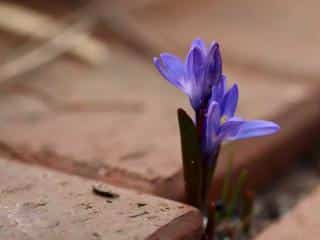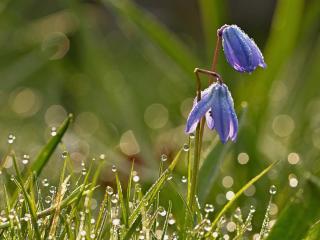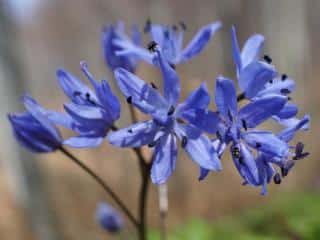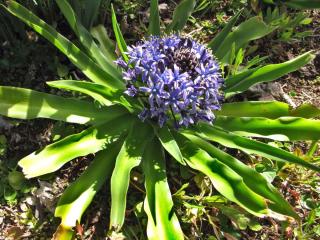

Like hyacinth and camas, it’s very easy to grow squill bulbs.
Summary of key Squill facts
Name – Scilla
Common name – forest hyacinth
Family – Scilloideae
Type – spring bulb
Height – 8 to 16″ (20 to 40 cm)
Soil – ordinary
Exposure: full, part sun – Outdoor blooming: end of spring, early summer
This bulb produces nice blooms in spring, and decorates gardens or terraces with beautiful white or blue flowers.
Most squills bloom in spring, providing beautiful fragrant bells in the early days of the season.
Group the bulbs in clusters, with only little space between flowers, instead of spreading them throughout the garden.
 It is best to plant your squills in fall, 4 inches (10 cm) deep, and they will bloom in spring.
It is best to plant your squills in fall, 4 inches (10 cm) deep, and they will bloom in spring.Squills that are planted in fall will bloom in spring. This is the normal, natural blooming cycle.
 Cut floral scapes off when they are wilted, but keep the leaves untouched.
Cut floral scapes off when they are wilted, but keep the leaves untouched.There are many different squill varieties, which each have different flowers and blooming seasons.

Another common one is the two-leafed squill, shown in the main article picture at the top. It blooms in spring and particularly loves growing on cool forest floors.
Spring squills, with scientific name Tractema verna, are a species that is mostly found along the Atlantic coast, or in the Pyrenees mountain range in low altitude. The Pyrenees is also where Lily-hyacinth squills Tractema lilio-hyacinthus are found, so named because they look like lilies.

Among the fall-blooming squills, there is the one called Prospero autumnale.
Squills bloom year after year without any care at all. Plant them in different exposures, as your garden permits, to stage blooming for as long as possible.
Our tip: forget about care, just sit back and savor the blooming every year!
I have Siberian squill throughout my lawn. I love the early burst of colour.
But I had one Puschkinia scilloides (Lebanese squill) that came up from under a rock wall the last few years, but never spread.
This year I was waiting for the seeds to dry, but had to remove the plant early due to wall renovation. Unfortunately I couldn’t get it out intact and the stalk separated from the bulb.
The leaves were still green. The seed pods were large, but also still green. What is the best way to store/plant the bulb? Will the seeds still be viable when dried off the plant?
So disappointed because it has a beautiful little flower spear.
It’s hard to say. Normally seeds really need to ripen on the plant, so they might not sprout. That being said, if you give them a good sprouting environment, that might counter the lack of maturity. Only trying out will tell!
For the bulb, best is to store it in a dry, dark place, for instance in a pot with sand set in a cool cellar. Keep it there during all of summer and transplant it to the ground in fall when temperatures have dropped to around the same temperature as your cellar. Hopefully it still has enough nutrients in it to grow a new set of leaves next year, but it’s always hard to know for sure.
My scillia Peruviana are done blooming, the leaves are now long and droopy. How do I take care of them now? Do I keep on watering them? I live in Phoenix Arizona and pretty soon it will be over 100 degres.
Thanks.
Hi Fran, no, at this stage you should leave them to fend off on their own. They’re early bloomers, and the nutrient-gathering phase that follows is also short. Other flowers are like this, too: crocus, snowdrop… each of these already starts “hibernating” to avoid the worst of summer. Maybe we should call it “summerating”? 🤔
Only cut leaves off, if you must, when they’ve turned yellow and/or dried out.
I planted some squill years ago. Since then, they have spread far and wide, but not closely together. Do I just have to plant more bulbs next fall to get that dense look? Or is there some other way ?
Hello Beth, planting more bulbs is of course one way to go, but it isn’t the only one. There are two-three things you can try first:
– remember to deadhead the flowers. Once they wilt, remove the flower stalk but don’t touch the leaves. This will channel the plant’s energy into splitting out new bulbs instead of making seeds (seeds won’t sprout as often).
– add a 2-inch (5 cm) layer of rich compost. Place it carefully by hand to keep the leaves above the layer. This will nourish the bulbs in the long term. We’ve done this with tulips and each bulb became an extra 4 or 5 bulbs in the following year.
– in the same vein, try preparing a batch of fermented weed tea. This is very helpful to help bulbs stock up on nutrients as well. Apply only during the phase when leaves aren’t yet starting to turn yellow.
Lastly, as with many low-lying forest flowers, you should know that squills didn’t develop to “hog the resources”. This means it’s rare to see a truly dense patch of squills in the wild. This type of plant aims to spread far and not so dense. It tries to catch as much sunlight as it can without disturbing its sister-flowers. This explains the natural distance between plants in a forest setting where shade and sun dot the ground and shift as days and seasons go by. You’d find some large patches in a clearing after a tree is felled, but then it’s often quickly overrun by ferns and the like.